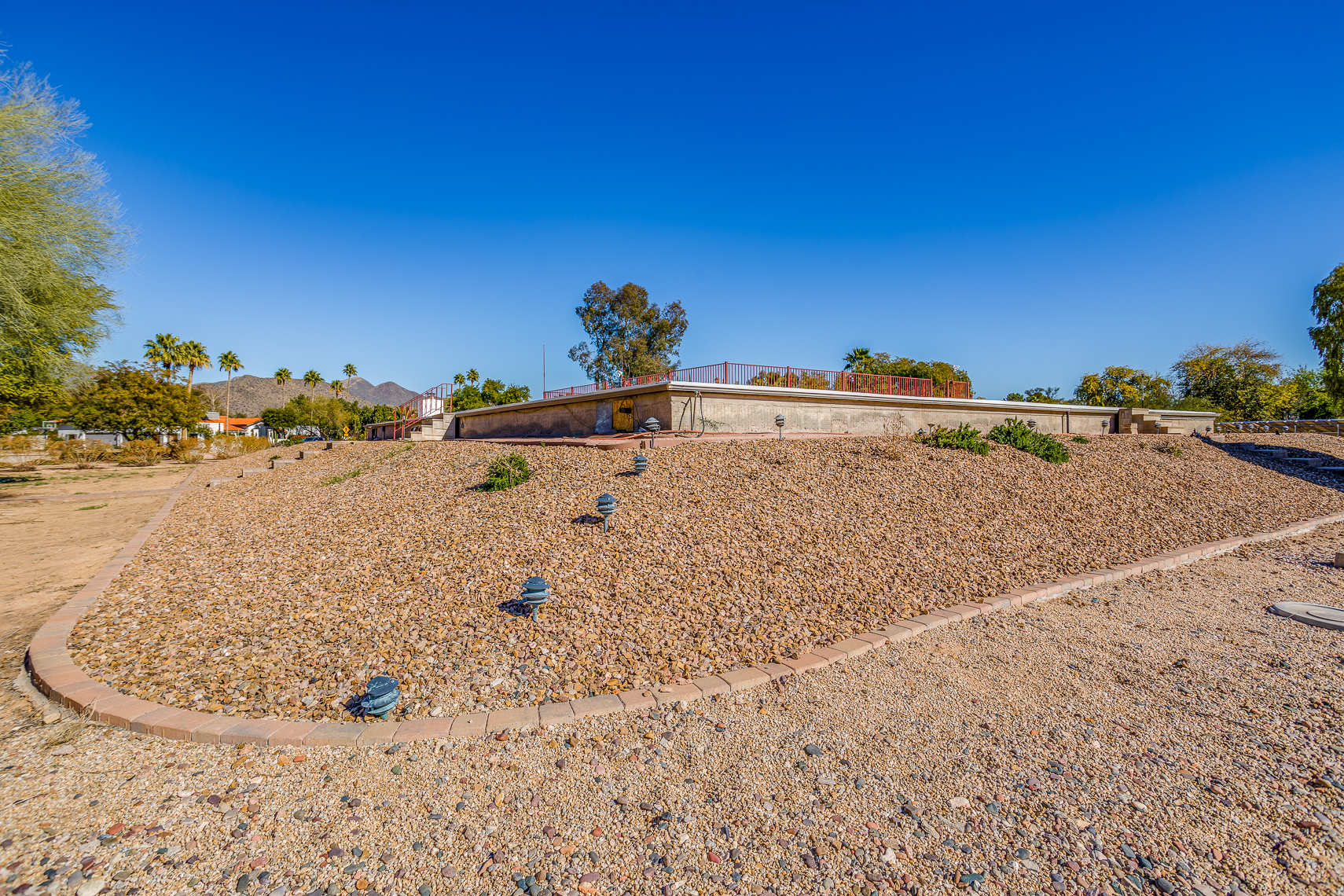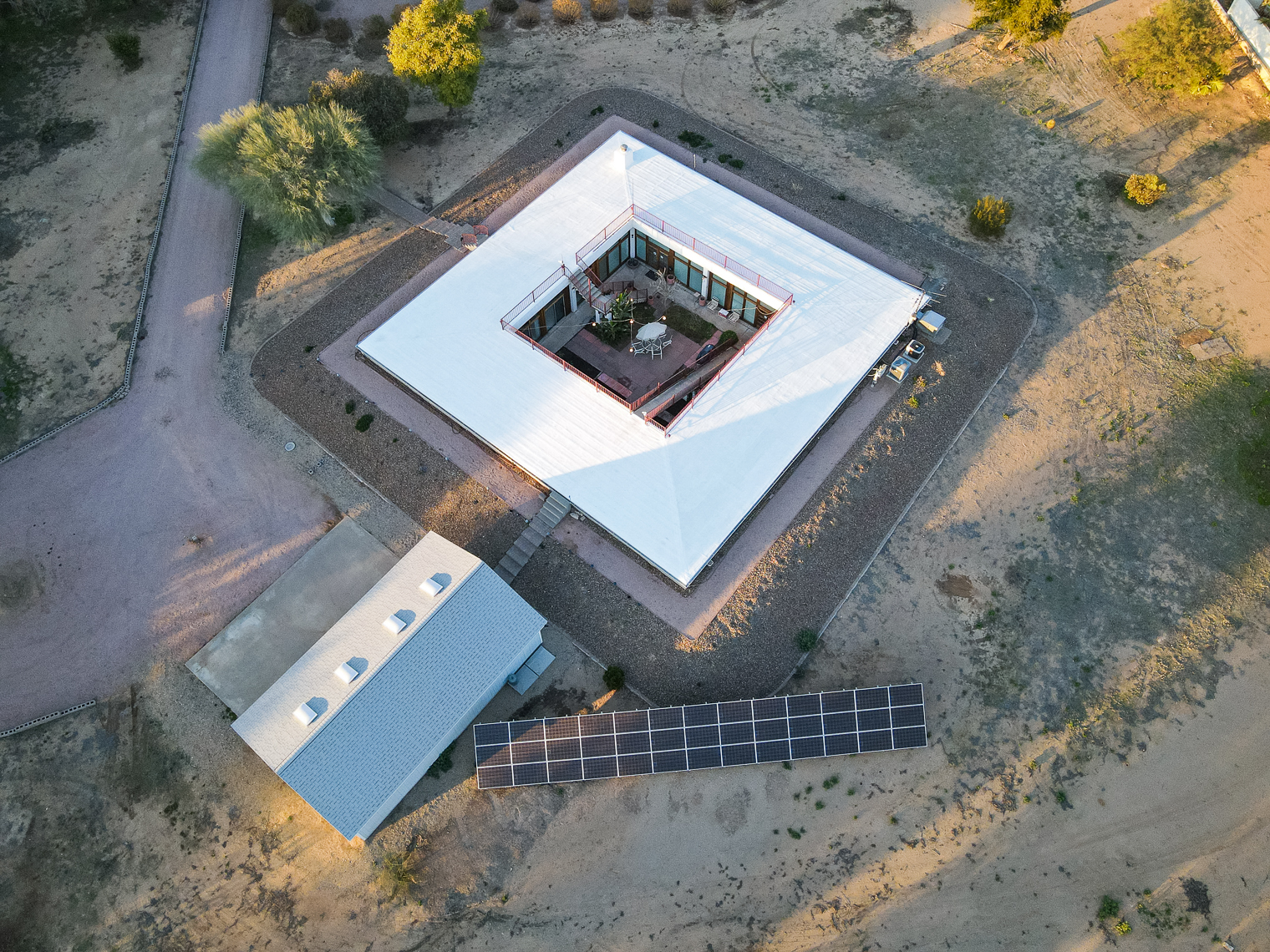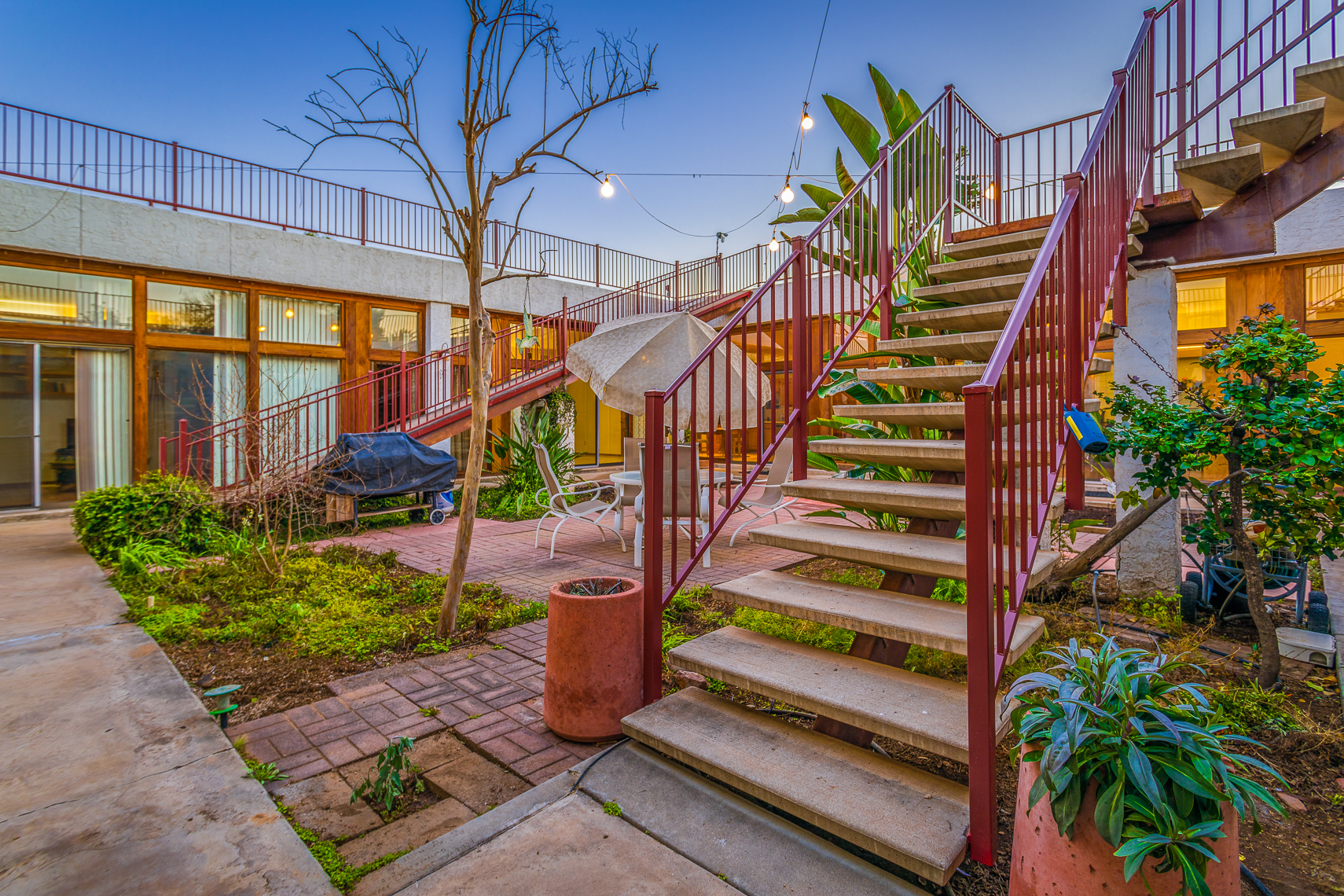Be part of the conversation: azarchitecture/Jarson & Jarson Architecture blog covers architecture and civic topics that comment on what’s happening in the Valley’s diverse design community. Here’s what’s happening now:

Subterranean Culture: A Spotlight on the Jimenez House – Part 2
It starts as a dream. An echo in the desert sand. A stirring in the brush. And then movement.
About a week ago, I wrote a blog post about Ray and Fae Jimenez’s subterranean house. The house was garnering a lot of attention on the internet, and I couldn’t stop thinking about it. I wanted to know more about its history, to gain more insight into what went into making this dream a reality.
To settle my own curiosity, I managed to get ahold of Desmond Jimenez, Ray and Fae’s oldest son. The house just cleared escrow, and he was willing to give me some insight.
We decided to get lunch at Los Olivos, a restaurant I had always loved as a kid, but had failed to return to in about a decade. Desmond came through the door sporting a Taliesin Foundation cap, a forest green vest, and a friendly smile. The house just sold, and he had one day left here.
“It’s done,” he said with a sigh of relief.
After a quick introduction, he looked at my well-used vintage car and asked, “Do you want to walk?”
The temperatures were rising, but it was a nice, spring day and it might’ve been the last time I could feel a cool breeze walking across the street. I wanted to talk about the house, to get a general history, and maybe dive deeper into the how and why. Des grew up in the valley, too. As it turned out, his wife was best friends with my aunt.
“Nora stayed at the Jarson Ranch when she was working with Sony. She stayed with your grandfather, and your aunt was there at the time, I think. Your grandfather was one of a kind. It’s been super cool to reconnect with everyone.”
My time at my grandparents’ ranch were distant memories, but they felt close. It wasn’t an underground house, but it was a meeting center. Every holiday was an excuse for a wild party, the rooms were bursting with people. An entire scene went on there, back when that sort of thing could happen.
I told him I agreed. My grandparents were definitely one of a kind.
When we rounded the corner, I pivoted back to the house. “There’s been a lot of talk about the subterranean house your dad built.”
“That’s great. This has been a whirlwind. I mean, it’s all happened so fast. Which is good. I’m not complaining.”
We both stopped to wait for the light to signal us to walk.
Then he laughed. “Well, I am complaining. Let’s just get right into it. My parents lived in the house for forty-freakin’ years. And it has the biggest closet on the planet. So, I mean, seven thousand pounds to the landfill, and I’m on my second set of donations to the charitable organization, and I gotta be gone tomorrow, you know? It’s been intense. That’s the end of the whining, okay?”
I almost forgot about the enormous closet inside the house. In the back of each room was a door that led to the storage closet. It was like a catacomb that ran across the perimeter of the home. The design was actually pretty cool and handy, but it must have been a lot of work to sort through every item after decades of collecting them.
I had pages of notes, but as I read through them, they read like gibberish. It didn’t matter what I wrote down the night prior. That was just work, setting up a frame I could use as a jumping off point. We were just talking, and once we stepped into the restaurant and ordered food, I closed my notebook. That’s when our conversation really began.
I want to talk about the house. What was it like at get-togethers or parties? I assume when people were over, the courtyard or atrium was heavily utilized.
Well, it was the main function even before it was a house. I was this big, [gestures with his hands, about the size of a baby] and I was living with my mom in Central Phoenix. It was just Fae, my mom, and me in a ‘48 Plymouth. We were probably living at 56th Street and Exeter, in the grove where they invented frozen OJ.
Back then, the roads ended at Camelback and Scottsdale Road. You didn’t go past that, really. She met with a real estate agent, drove out to the edge of town there, and looked at the land. It was 1955, maybe 1956. I was just months old. That’s when they bought the land. They paid $2,000 for 3.2 acres of desert.
Not a bad price.
Laughs. Later, my dad was an engineer at Motorola. They would all go out there. When I was in high school, we called them Boondockers. They would just build a fire in the middle of that property, bring chairs, and my mom would make cowboy beans, and they would drink beer and talk crap about politics. That’s what they did.
It really was a meeting center, even before it was a house. It was this weird hub of aerospace engineers, who would just go out there at least once a year and do stuff like that.
That atrium was designed to keep that happening, even though there’s a house all the way around it.
Was your father an architect prior? How did this come together?
My grandmother Gertrude was one of two women in her graduate class in 1924. She was a draftswoman, so that’s as close to being an architect without going to architect school. So she was the one who actually did the design and drew out all the blueprints.
Thinking to himself. Let’s see, the big crash was in 1929. Her husband had come from Panama.
She had something to do with the canal, right?
Yep. She was a draftswoman in the Panama Canal design.
Have you traveled there?
Oh, yeah. We went looking for her house. She had a couple of houses there. I lived in Costa Rica. And in 1968, we went to see if we could figure out what was going on with the houses because she had all the deeds and everything. But there was some stuff going with the government. Everything had turned over.
She came to the U.S. in 1946 in a banana boat with my dad and my brother. They tried to leave in ‘45, but apparently there were still U-boats that didn’t get the message. They thought the war was still going. So they had to wait for the banana boat.
Then they were in Eureka, Illinois for about a year. And then they moved to Arizona, to a Sun City town home.
What made her move to Arizona after Illinois?
The cold.
Makes sense. I wonder what Scottsdale was like in 1946.
1946, there were 40,000 people here. Can you imagine?
It makes you nostalgic for something you never even experienced.
Totally.
She eventually sold the Sun City home, and part of that money went into the financing of my dad’s place. The banks wouldn’t loan him the money.
It was all self-funded?
Yeah. He was one of the first hundred employees at Motorola. He had a good job. I mean, you wanna buy a track home? It’s 1955. There’s a million of them. Basically, they were creating the baby boom. My dad had this one idea, and he worked on it for about twenty-years. He had enough cash to at least dig the hole and build half of it. And that’s what they lived in for about a year. Then it was a ten year project to finish it, to get what you’re looking at right now.
Ten years is a long time.
He really started laying it down in 1975. So it took him about twenty years to really think it through.
What was the main driving force behind the idea? To conserve energy?
We have pictures of him in, I think, 1973, There was the OPEC oil crisis and gas went from oh, twenty-nine cents per gallon to a buck fifteen. Everyone thought it was the end of the world. You know?
Have you looked at the price at the pump lately?
We both laugh.
The home has conventional heating and cooling now, right?
Where my family lives now, we get the Delta breeze off the bay, so it drops to sixty degrees. But when you’re outside at night in Phoenix in the summer, it’s still about a hundred.
Initially, it was just evaporative cooling. That’s all they had. Day to day variations were about five degrees, and they still basically are. Twenty years later, my mom wanted it a few degrees cooler in the summer. The energy bill averages about $20 bucks a month.
I can’t even imagine.
Well, I should add that the home is photovoltaic. Solar. There’s that design element that allows multiple generations to interact with the home. It’s all very functional.
Not only is there a ramp leading you into the atrium, you can also choose the stairs.
Well, the ramp was put in to get a refrigerator out. Otherwise, you gotta get a crane. Laughs.
Everything comes back to stories for me. If there’s no story, there’s no heart, no reason to push forward. A world without stories is empty. And what your home has made me realize is that these are not only places of shelter, but places of gathering. Let’s go back to the history of the house. How did it come to be?
It was a combination of my dad’s engineering skills, and my grandmother’s ability to convert that into a design. But what was more important was that my mom was a painter. She wanted the light. There’s this video of her saying, “I don’t want to live in a cave,” and an awful lot of earthbound homes are dug in, so you don’t get any light. There’s conservation, but it has to be aesthetically pleasing.
Spaces have an energy that shape us.
You know, I think my favorite car was a 1950’s Bugatti. At the time the guy built that car, he was quoted as saying, “No feat of engineering is ever considered complete, until it’s aesthetically pleasing.” And I think that’s kind of what my mom pushed, to give the house that feeling. That was the element that made that house work.
You can definitely feel it just by looking at it.
My dad also knew how to live in the desert. He really did. He got here when he was thirteen, he went to North High School, which meant he rode five miles on a bike to school. In the summer, that distance doubled when he wanted to play baseball. They were all wearing wool uniforms back then. So he understands the desert intuitively.
Systems really shape the rhythm of a society. And I want to get back to that before we wrap up. Where were you in all of this?
Well, I left Arizona when I was eighteen. I came back when I was twenty one, and I went to Tucson for ten years. I was in the military until 1977. I had the good graces of being brought up around a lot of culture, a lot of different people. You know, when you’re young, you’re a little in the backwater. There’s some turbulence out there, but that’s good.
I love this topic because when you’re looking at homes, you’re making up stories in your head to allow yourself to feel a bit of it, real or not. It’s not just an investment of money, it’s an investment of time. There is both love and hardship. Big things happen in these places.
Totally.
At the heart of a home, there’s a center that brings everything together. It doesn’t keep, it allows people to travel freely, and if you’re lucky, its geometry is respectful to the mood. That center is sort of like a petri dish of culture. Everyone mixes together, and something is made.
Yeah. Have you been to Amsterdam?
A few times. Beautiful city.
So you know how that worked. I mean, that’s another example, a human petri dish. A center sectored off by waterways, and a ton of people experiencing things like sardines. And then, of course, you have the outside world, which was either coming or going. It’s just… pleasant.
I think in many ways it’s time for a jumpstart, or a new set of rules to apply that’s congruent with modern technology. But it can’t be cheap and easy. We need ideas that resonate, and it can’t just be one person. My hunch is that it’s already happening, that we’re seeing it play out, and right now we’re experiencing some of that turbulence you were describing.
I think the question that we ask is, why? Why do we do what we’re doing? We grew up spiritually, but my father didn’t have any real religious upbringing. What my dad did was find himself in the desert, unsure what that why was. He built boxes that would protect electronics for the Gemini space capsules. So his whole thing was we’re going to outer space, then it went into learning all about energy conservation. That was his why. Then that translated into how was he going to live? The house was really his how. He was thinking, “We should live better.”
Thanks for your time, Des.
Thank you.




